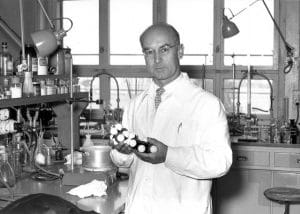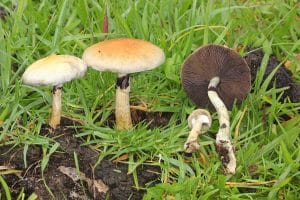In the late 50s and early 60s, Albert Hofffman, the Swiss chemist credited with synthesizing and self-testing LSD, also became the first-known individual to isolate, synthesize, and subsequently name and study the principal psychedelic mushroom compounds psilocybin and psilocin. In doing so, Hoffman tied himself anthropologically and spiritually to shamanistic and cultural practices that reach back approximately 30,000 years in time, to the Upper Paleolithic/Late Stone Age. In what might be called karmic resonance, it is reported that a shaman later pronounced Hofmann’s pill version of psilocybin mushrooms, “the same”.
But what exactly are these magical substances that now promise to not only provide a mechanism to treat issues such as depression, anxiety, PTSD, and ADHD, but dramatically redefine the term “mental health” in more multidimensional ways which have a mystical underpinning, thus touching off a new era that connects humans to themselves and their collective ancient past? As Hoffman stated so eloquently himself:
I share the belief of many of my contemporaries that the spiritual crisis pervading all spheres of Western industrial society can be remedied only by a change in our world view. We shall have to shift from the materialistic, dualistic belief that people and their environment are separate, toward a new consciousness of an all-encompassing reality, which embraces the experiencing ego, a reality in which people feel their oneness with animate nature and all of creation.

Now, I’m going to get a bit technical here about the chemical nature of psilocybin and psilocin, so bear with me, because a better understanding of the structure and function of psilocybin and psilocin bolsters a deeper appreciation of the more cosmic and mystical aspects of the psychedelic experience.
Psilocybin, (PY, 4-phosphoryloxy-N,N-dimethyltryptamine), along with psilocin (4-hydroxy-N,N-dimethyltryptamine), belong to a class of compounds known as tryptamines, “a group of monoamine alkaloids (indolalkylamines) derived from the amino acid tryptophan, that can be found in natural sources including plants, fungi [ie., ‘magic mushrooms’], microbes, and amphibia.” Both compounds are present in magic mushrooms, slang for a group of fungi (say that 3 times quickly but not while tripping) belonging to the Hymenogastraceae family, which includes Psilocybe cubensis, Psilocybe mexicana, Psilocybe azurescens, and Psilocybe semilanceata, among others.
There are also other psychedelic compounds in various concentrations, including norpsilocin, baeocystin, norbaeocystin, and aeruginascin, but for purposes of clarity and focus, we’ll limit our exploration to psilocybin and psilocin.

Although psilocybin is frequently credited for the hallucinogenic and mind-expanding properties of a magic mushroom “trip,” in reality it is psilocin that is responsible for these physiological reactions. Psilocybin is a prodrug, a “pharmacologically inactive compound that is transformed into an active substance when it reacts or is metabolized in mammalian systems.”
Through a biochemical process known as dephosphorylation, which occurs in the presence of stomach acid, psilocybin is converted into psilocin, which is ultimately responsible for inducing all of the psychedelic effects, such as a distorted sense of time and space, auditory and visual hallucinations, synesthesia, and a sense of connected to the cosmos precipitated by the dissolution of the ego.
Once this conversion of psilocybin to psilocin takes place, the drug is then distributed throughout the body via the blood supply, including the primary target, the brain. And because psilocin is lipid soluble, it easily and rapidly crosses the blood brain barrier.
As you may know, our brains, on a biochemical level, are regulated by neurotransmitters, chemicals used by the body’s nervous system to transmit messages between neurons, thus allowing us to apprehend and react to stimuli, process information, feel emotions, and move our bodies. In this sense, neurotransmitters govern not only our unconscious processes, but our very consciousness itself.
One of those neurotransmitters is serotonin, which came into sharp scientific focus with the introduction of Selective Serotonin Reuptake Inhibitors (SSRIs) in the late 80s with the release of medications such as Prozac, Paxil, and Zoloft. The idea behind SSRIs is to make serotonin more readily available to our brains, thus theoretically correcting some type of “chemical imbalance,” and leading to the lessening of symptoms of depression.
And although the efficacy of these drugs, not to mention their negative side-effect profiles, have come to be questioned by the scientific community, the role of serotonin cannot be understated, and is the primary target of psilocin.
By biochemically modifying nerve signaling, an intercellular communication system that allows our nerves “ . . .to crackle, fizz and buzz along as they make us jump up or sit down, laugh and cry, love and hate, sing, shout, swear, eat, drink and do everything that makes us human,” psilocin, through its hallucinogenic and psychotropic properties, has a pronounced serotonergic effect on our perceptions and consciousness.
And though we are in the early stages of scientific investigations, there is a theoretical physiological/biochemical perspective that may help us connect the brain and our consciousness to a spiritual dimension.
Writing for the publication Psychedelic Scientific Review, Barbara E. Bauer, who has a masters degree in human physiology/biochemistry from Central Michigan University, conducted a review of experimental psychedelic literature, and found “When hallucinogens bind with postsynaptic 5-HT2A receptors in cortical neurons [serotonin receptors], this changes cellular signaling and functioning via the excitatory amino acid glutamine. The effect is what the authors describe as ‘complex manifestations in consciousness.’”
What Bauer is getting at is profound to say the least, because it appears there is some type of physiological component to consciousness, though the process is likely so complex, interconnected, and interdependent that we may never unravel its essence, or at least our understanding of its essence.
However, it is this dynamic of interconnected and interdependency that is the crux of the matter, which begs the question, could it be possible that psilocybin, via the pathways of psilocin, sets up a “neuronal connectedness” that mirrors the cosmic connected of all matter, including human beings? After all, the astronomer, modern-day philosopher, and marijuana advocate Carl Sagan pointed out, “We are made of star stuff.”
If this sounds far fetched, consider this. According to Cardiff University biosciences professor Lynne Boddy, “[Fungi] are the garbage disposal agents of the natural world. They break down dead, organic matter and by doing that they release nutrients and those nutrients are then made available for plants to carry on growing.” And the growth of plants is what produces oxygen, which sustains a great deal of life on earth, including you and me, thus setting in motion a web of intimate interconnectedness among all life forms. As Rob Dunn, a professor at North Carolina State University frames it, “It’s how everything is reborn. So that this entire web of life is connected and it’s connected through the fungi.”
This sentiment of interconnectedness allows us to dissolve the artificial barriers that have divided science and cosmic spirituality throughout modern times. As Albert Hoffman put it so eloquently, “We can study material processes and various processes at the energetic level, that is what we can do as natural scientists. And then there comes something quite different, the psychic experience, which remains a mystery.”
I think Hoffman would be happy that we are attempting to explore this mystery in meaningful ways.
At Newsweed.com, we adhere to three simple principles: truth, balance, and relatability. Our articles, podcasts, and videos strive to present content in an accurate, fair, yet compelling and timely manner. We avoid pushing personal or ideological agendas because our only agenda is creating quality content for our audience, whom we are here to serve. That is why our motto is ”Rolling with the times, straining for the truth.”
Your opinion matters. Please share your thoughts in our survey so that Newsweed can better serve you.
Charles Bukowski, the Los Angeles beat poet that captured the depravity of American urban life once said, “There is something about writing poetry that brings a man close to the cliff’s edge.” Newsweed is proud to stand in solidarity and offer you a chance to get close to the cliff’s edge with our first Power of Poetry Contest. Are you a budding bard, a versatile versifier, a rhyming regaler? Do you march to the beat of iambic pentameter, or flow like a river with free verse? If so, here’s your opportunity to put your mad poetic chops to the test. Enter our poetry contest for bragging rights and an opportunity to win some cash!






